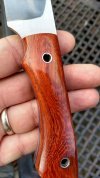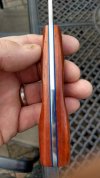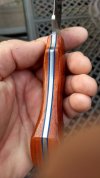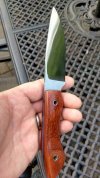- Joined
- Jul 31, 2015
- Messages
- 3,118
I just finished the handle on the knife below, except for a coat of hand rubbed wax, which made it just a bit shinier. It is un-stabilized Padauk currently at 600 grit finish then buffed with very fine compound. I am happy with the finish, but have a few questions.
1. I understand that the color will likely fade with time to more of a brown, I'm ok with that as I don't think there is much I can do to stop it. Is that a problem?
2. The wood has some fine checks in it, as I understand is inherent with this wood. I don't mind the look, I kind of like it actually. Is this something I should be concerned about?
3. Any directions I should give the buyer other than the usual (clean it, dry it off after use, don't put it in the dishwasher).
As always- Thanks in advance for your help.




1. I understand that the color will likely fade with time to more of a brown, I'm ok with that as I don't think there is much I can do to stop it. Is that a problem?
2. The wood has some fine checks in it, as I understand is inherent with this wood. I don't mind the look, I kind of like it actually. Is this something I should be concerned about?
3. Any directions I should give the buyer other than the usual (clean it, dry it off after use, don't put it in the dishwasher).
As always- Thanks in advance for your help.




